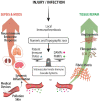Evolutionary Insight into Immunothrombosis as a Healing Mechanism
- PMID: 35955499
- PMCID: PMC9368803
- DOI: 10.3390/ijms23158346
Evolutionary Insight into Immunothrombosis as a Healing Mechanism
Abstract
Both invertebrates and vertebrates possess a cluster of immediate and local wound-sealing, pathogen-killing, and tissue healing responses known as immunoclotting and immunothrombosis, respectively, to cope with two life-threatening emergencies, namely, bleeding and microbial invasion. Despite their convergence in function, immunoclotting and immunothrombosis are deployed by different blood cells and intravascular multidomain proteins. In vertebrates, these proteins share some domains with intrinsic chemical affinities useful in generating cooperative networks such as pathogen and damage pattern recognition molecules. Moreover, many of the proteins involved in coagulation and fibrinolysis in humans are multifunctional molecules playing roles in other processes from inflammation to healing and beyond. In our modern society, however, the interaction of activated intravascular allosteric proteins with one another and with blood cells entails vulnerabilities posing a biological paradox: intravascular proteins that locally operate as tissue repair enhancers can nevertheless generate pathogenic processes by acting systemically. In this manuscript, we contextualize and frame the coagulation system and hemostasis through an evolutionary time scale, illustrating their role as dual players in the defense against exsanguination and pathogens while significantly influencing wound healing.
Keywords: coagulation; complement system; evolution; fibrinogen; growth factors; healing; hemostasis; platelets.
Conflict of interest statement
The authors declare that E.A. is the Scientific Director of and S.P. and R.P. are scientists at BTI Biotechnology Institute, a biomedical company that investigates in the fields of regenerative medicine and PRGF-Endoret technology.
Figures




Similar articles
-
Healing through the lens of immunothrombosis: Biology-inspired, evolution-tailored, and human-engineered biomimetic therapies.Biomaterials. 2021 Dec;279:121205. doi: 10.1016/j.biomaterials.2021.121205. Epub 2021 Oct 21. Biomaterials. 2021. PMID: 34710794 Review.
-
Innate immune signaling and immunothrombosis: New insights and therapeutic opportunities.Eur J Immunol. 2022 Jul;52(7):1024-1034. doi: 10.1002/eji.202149410. Epub 2022 May 24. Eur J Immunol. 2022. PMID: 35569038 Free PMC article. Review.
-
Fibrinogen and factor XIII at the intersection of coagulation, fibrinolysis and inflammation.Thromb Haemost. 2014 Oct;112(4):649-58. doi: 10.1160/TH14-01-0085. Epub 2014 Aug 28. Thromb Haemost. 2014. PMID: 25182841 Review.
-
Local hemostasis, immunothrombosis, and systemic disseminated intravascular coagulation in trauma and traumatic shock.Crit Care. 2015 Feb 23;19(1):72. doi: 10.1186/s13054-015-0735-x. Crit Care. 2015. PMID: 25886801 Free PMC article. Review.
-
The coagulation system and its function in early immune defense.Thromb Haemost. 2014 Oct;112(4):640-8. doi: 10.1160/TH14-01-0053. Epub 2014 Apr 3. Thromb Haemost. 2014. PMID: 24696161 Review.
Cited by
-
Biomimetic nano dressing in wound healing: design strategies and application.Burns Trauma. 2025 Jun 10;13:tkaf038. doi: 10.1093/burnst/tkaf038. eCollection 2025. Burns Trauma. 2025. PMID: 40757163 Free PMC article. Review.
-
Neutrophil extracellular traps mediate neuro-immunothrombosis.Neural Regen Res. 2024 Aug 1;19(8):1734-1740. doi: 10.4103/1673-5374.389625. Epub 2023 Dec 11. Neural Regen Res. 2024. PMID: 38103239 Free PMC article.
References
-
- Doolittle R.F. The Evolution of Vertebrate Blood Clotting. University Science Books; Melville, NY, USA: 2012.
MeSH terms
LinkOut - more resources
Full Text Sources

